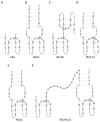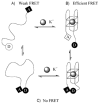G-Quadruplex-Forming Aptamers-Characteristics, Applications, and Perspectives
- PMID: 31640176
- PMCID: PMC6832456
- DOI: 10.3390/molecules24203781
G-Quadruplex-Forming Aptamers-Characteristics, Applications, and Perspectives
Abstract
G-quadruplexes constitute a unique class of nucleic acid structures formed by G-rich oligonucleotides of DNA- or RNA-type. Depending on their chemical nature, loops length, and localization in the sequence or structure molecularity, G-quadruplexes are highly polymorphic structures showing various folding topologies. They may be formed in the human genome where they are believed to play a pivotal role in the regulation of multiple biological processes such as replication, transcription, and translation. Thus, natural G-quadruplex structures became prospective targets for disease treatment. The fast development of systematic evolution of ligands by exponential enrichment (SELEX) technologies provided a number of G-rich aptamers revealing the potential of G-quadruplex structures as a promising molecular tool targeted toward various biologically important ligands. Because of their high stability, increased cellular uptake, ease of chemical modification, minor production costs, and convenient storage, G-rich aptamers became interesting therapeutic and diagnostic alternatives to antibodies. In this review, we describe the recent advances in the development of G-quadruplex based aptamers by focusing on the therapeutic and diagnostic potential of this exceptional class of nucleic acid structures.
Keywords: G-quadruplexes; anticoagulants; antiviral agents; aptamers; aptasensors; cancer; conjugates; diagnostics; therapeutics.
Conflict of interest statement
The authors declare no conflict of interest.
Figures












References
Publication types
MeSH terms
Substances
LinkOut - more resources
Full Text Sources
Other Literature Sources

